I'm building a device using
- TUSB2046B hub controller
- 4x FT230X USB to UART controller
First, let's look on Hub controller sample application:
Note D:
All USB DP, DM signal pairs require series resistors of approximately 27 Ohm to ensure proper termination. An optional filter capacitor of about 22 pF is recommended for EMI suppression. This capacitor, if used, must be placed between the hub terminal and the series resistor, as per section 7.1.6 of the USB specification.
Then let's look on FT230X sample application:
My questions:
- What is the purpose of 15kOhom resistors to ground on first image? Are they necessary in single pcb layout?
- How should I connect those two devices assuming single pcb layout with no more then 5cm distance?
This is the most intuitive idea:

simulate this circuit – Schematic created using CircuitLab
And some questions:
- Can I safely remove one 27 Ohm resistor on each line? Must I change the remaining one to 54 Ohm?
- Is there any difference whether capacitors are 22pF or 47pF?
- Are those capacitors necessary?

